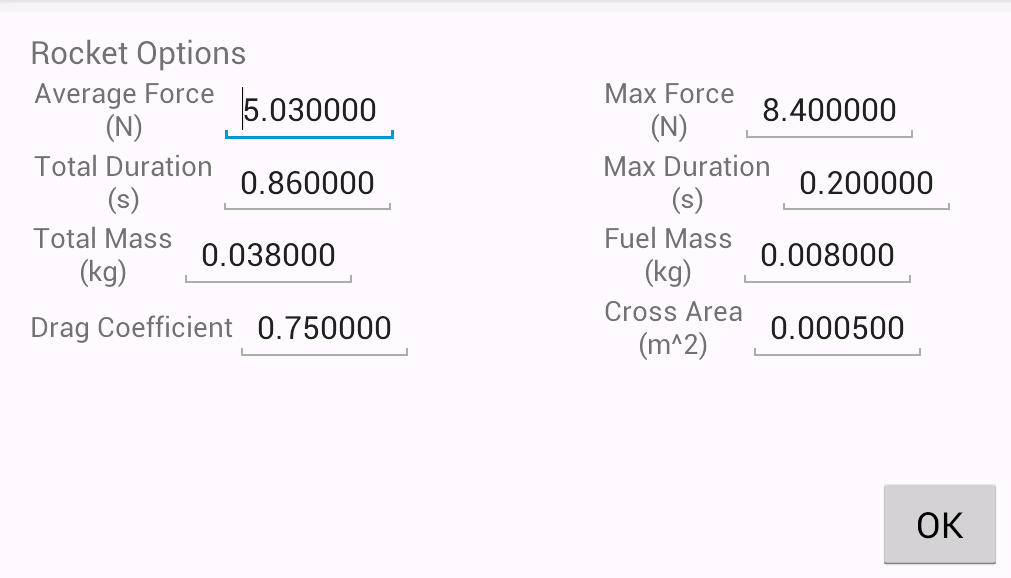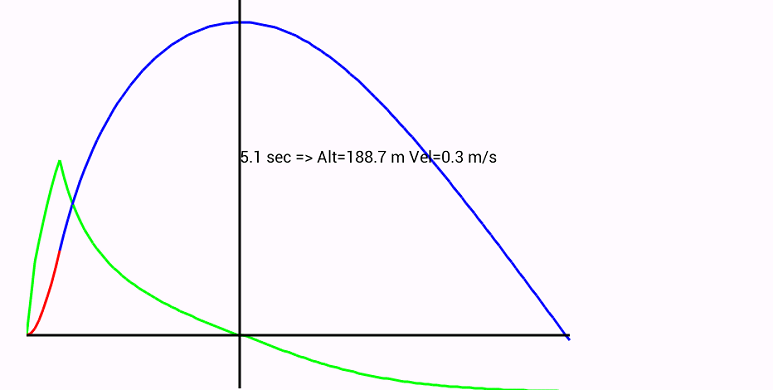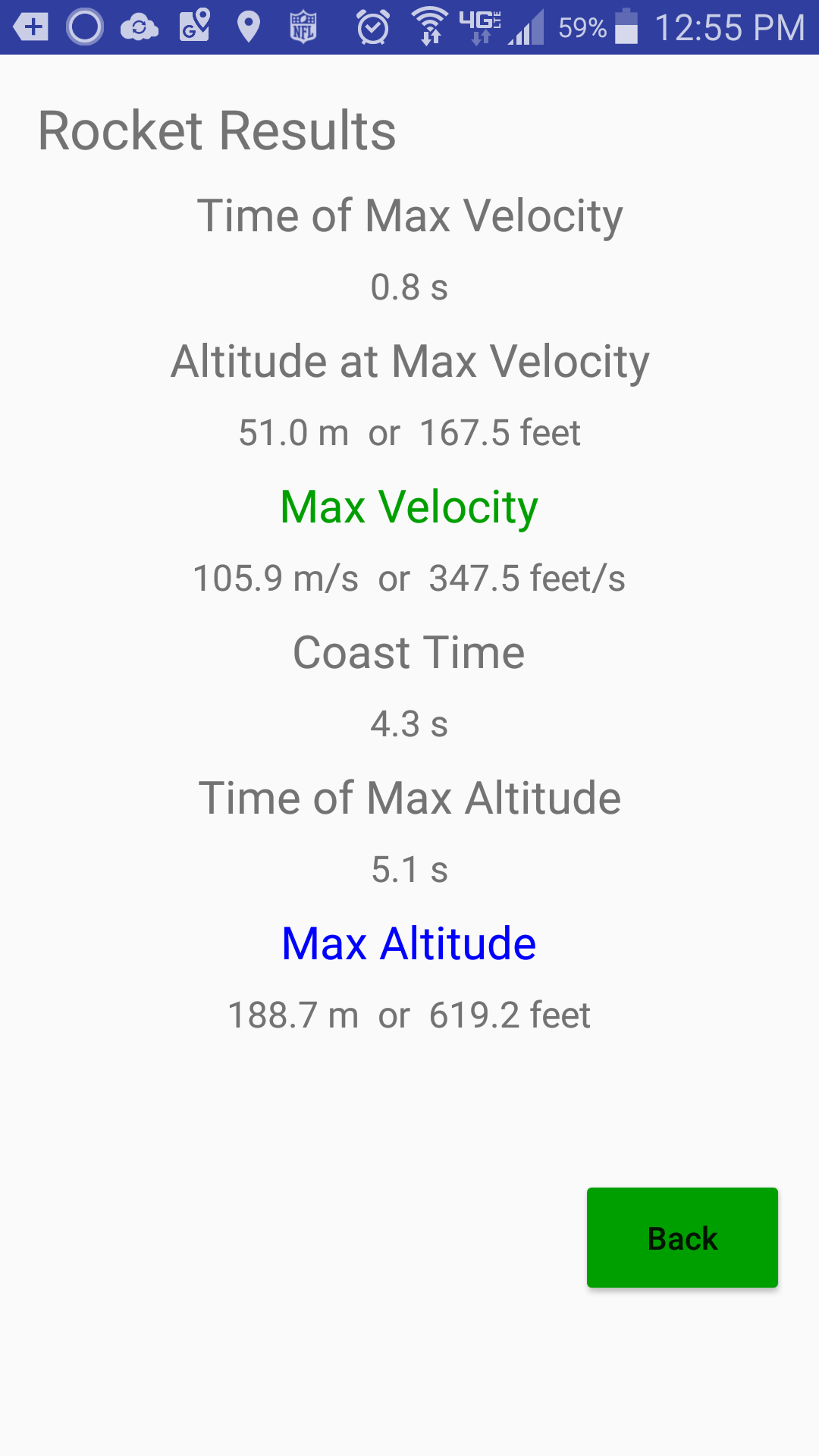
To use RocketCalc, start by downloading the Android app to your Android smartphone.
Link to RocketCalc for Android smartphones
for Android smartphones
RocketCalc is a calculator to determine the altitude and velocity a model rocket is likely to achieve. To configure the parameters of your rocket, go to the Parameters menu item at the top of the main screen, or under the button in the upper right corner, and enter into RocketCalc the parameters of your model rocket and rocket engine.

RocketCalc will then display the likely flight profile. You can tap on the RocketCalc flight profile screen to find the altitude and velocity at any particular time during the rockets flight.

If you want to know the specific maximum velocity, maximum altitude, or coast time go to the Results menu item at the top of the main screen, or under the button in the upper right corner.

The paid version of RocketCalc, 'RocetCalc (No Ads)', allows you to save, and later open, up to four rocket parameter files. To save a rocket parameters go to File Save As under the button in the upper right corner, and select the file slot, one through four, that you want to save the parameters as. Once you save the file, if you make further changes to the parameters, you only need to select File Save to update the file, unless you want to change the file slot you're using. To open any file that you've saved at a later time, go to File Open under the button in the upper right corner, and select the file slot, one through four, that you want to open the parameters from.
The default parameter values preseted for RocketCalc are for a B6 rocket engine.
Students and teachers can use RocketCalc to calculate the likely flight profile or their own model rockets.
They will need to enter some information about their rocket such as total mass and cross sectional area,
and can come up with estimates for the parameters of the rocket engine based on the engine coding.
To estimate the parameters of the rocket engine based on the engine coding you could try to derive it from the documented meaning of the coding such as:
A8-#
'A' indicates total Newton-Seconds of the engine to be between 1.26 and 2.50 Ns
'8' should indicates average Newtons of 8 N
However, this doesn't include the time of max thrust, the total time of thrust, nor the fuel mass.
It also doesn't indicate actual measured values of engines.
Instead using static test data such as http://www.nar.org/SandT/pdf/Estes/A8.pdf would be better.
Reasonable values to enter into RocketCalc for an A8 engine would be:
Average Force: 3.18 N
Max Force: 4.0 N
Total Duration: 0.73 s
Max Duration: 0.2 s
Fuel Mass: .006 kg
Reasonable values to enter into RocketCalc for an B8 engine would be:
Average Force: 8.46 N
Max Force: 12.3 N
Total Duration: 0.5 s
Max Duration: 0.2 s
Fuel Mass: .008 kg
Reasonable values to enter into RocketCalc for an B6 engine would be:
Average Force: 5.03 N
Max Force: 8.4 N
Total Duration: 0.86 s
Max Duration: 0.2 s
Fuel Mass: .008 kg
Reasonable values to enter into RocketCalc for an C6 engine would be:
Average Force: 4.74 N
Max Force: 10.6 N
Total Duration: 1.86 s
Max Duration: 0.2 s
Fuel Mass: .014 kg
Reasonable values to enter into RocketCalc for an D12 engine would be:
Average Force: 10.21 N
Max Force: 20.7 N
Total Duration: 1.65 s
Max Duration: 0.3 s
Fuel Mass: .026 kg
Reasonable values to enter into RocketCalc for the Surveyor spacecraft solid propellant retro rocket would be:
Average Force: 40900 N
Max Force: 40900 N
Total Duration: 42.5 s
Max Duration: 42.5 s
Fuel Mass: 590 kg
OK, just making sure you were paying attention.
This rocketry calculator requires no network connection allowing you to work offline and use it anywhere.
Link to RocketCalc for Android smartphones
for Android smartphones
Copyright (C) 2017 R. J. Kuhn. Please note that you are not allowed to reproduce or rehost this page without written permission.